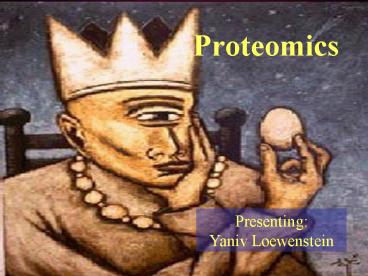Proteomics - PowerPoint PPT Presentation
1 / 28
Title:
Proteomics
Description:
Proteomics an emerging scientific discipline encompassing any ... Proteome analysis is conceptually attractive because of ... Experiment synopsis. Pulse ... – PowerPoint PPT presentation
Number of Views:155
Avg rating:3.0/5.0
Title: Proteomics
1
Proteomics
Presenting Yaniv Loewenstein
2
Say What?
- Proteome - the entire complement of proteins
produced in a cell or organism. - Proteomics an emerging scientific discipline
encompassing any method for the large scale
analysis of proteins.
3
Why proteomics?
- Proteome analysis is conceptually attractive
because of its potential to determine properties
of biological systems that are not apparent by
DNA or mRNA sequence analysis alone.
- quantity of protein expression.
- the subcellular location.
- the state of modification.
- the association with ligands.
- the rate of change with time of such properties.
4
Genome vs. Proteome Complexity
The proteome is much more complex than the genome.
- Alternative Splicing.
- RNA editing.
- Alternative use of different promoters and
terminators. - Post Translational Modifications.
1 Gene ? various proteins
5
Genome vs. Proteome Complexity (continued)
- Several genomes were solved but no eukaryotic
proteomes yet. - Current efforts
- PPAP - the plant proteome annotation project.
- (Arabidopsis thaliana)
- D.melanogaster , M. musculus, S.cerevisiae
and more. - Deinococcus radiodurans - proteome was complete
recently.
6
Major Tools
- 2D Gels.
- Pulse-Chase experiments.
- Chromatography.
- Mass Spectrometry.
- Immunoprecipitation.
- Bioinformatics and databases
- YPD, CATH, SCOPE, SWISSPROT, BLAST
7
2d gel
8
Pulse Chase
- QWhat is meant by a pulse-chase experiment?
- A
- Pulse A brief exposure to some labeling
condition (i.e. radioactive labeling). - Chase Removal of the label and observation of
the labeled material. - gt follow the fate of the labeled material.
9
Todays Topics
- Identification of in vivo substrates of the
chaperonin GroEL - Walid A. Houry , Dmitirij Frishman, Christoph
Eckerskorn, Friedrich Lottspeich F. Ulrich
Hartl. - A sampling of the yeast proteome. Futcher B,
Latter GI, Monardo P, McLaughlin CS, Garrels JI. - Correlation between protein and mRNA abundance in
yeast. Gygi SP, Rochon Y, Franza BR, Aebersold R
10
Protein Folding
- 3D fold of a protein is determined by the
amino-acid sequence. - Some proteins can reach their folded states
spontaneously. - The efficiency of folding is often limited by the
side reaction of aggregation. - Misfolding and aggregation of proteins is
prevented by molecular chaperones.
11
Molecular chaperones - what?
- Definition Proteins that interact with partially
folded or improperly folded polypepetides,
facilitating correct folding pathways or
providing microenvironments in which folding can
occur.
12
GroEL - I
- Essential. In E. Coli.
- Structure
- homo-oligomer.
- 2 heptamer rings.
- cofactor GroES ATP.
- some proteins may require several rounds.
- Hydrophobic interactions.
13
GroEl cycle Mechanism.
14
GroEl cycle Mechanism. II
15
Research Goals
- Define a Group of GroEL Subtrates.
- Search for common motifs in the GroEL substrate
proteins.
16
Experiment synopsis
- Pulse-chase labeling.
- At different times of chase, cells were lysed in
the presence of EDTA. - GroELsubstrate complexes were isolated by
immunoprecipitation with anti-GroEL antibodies. - ATP GroES added in vitro.
- Total soluble cytoplasmic proteins and
GroEL-bound proteins were separated on 2D gels. - Control experiments.
17
Substrates
- 250300 proteins out of a total of 2,500 were
observed in complex with GroEL immediately upon
labeling. - About half of these proteins were still
detectable on GroEL after 10 min of chase ,
though in much lower amounts relative to GroEL. - Proteins that interact only very transiently
with GroEL may have escaped detection in this
analysis.
18
A defined set of GroEL substrates Gel
19
GroEL substrates - pI and Mr
The pI distributions of total soluble cytoplasmic
proteins and of GroEL substrates were found to be
very similar.
E(total Mr) 37kD E(GroEL sub Mr) 45kD BUT
20kDltMrlt60kD
20
GroEL substrates - Kinetics
- a. 160 proteins (Mr lt 60k) released completely
with time constants between 20s and 2 min. - b. 100 proteins (Mr lt 60k), a fraction of the
substrates remained associated. - c. Several larger proteins (Mr gt 60k) were
inefficiently released from the chaperonin.
21
A defined set of GroEL substrates Gel
22
Additional experiments
- Proteins return to GroEL for additional cycles.
- Heat stress conditions.
23
GroEL substrates Identification.
- Analyze spots - MS.
- 52 of the most abundant, were unequivocally IDed.
- RNA poly subunits
- E.F Tu
- tRNA synthetases
- in accord with previous studies.
24
GroEl Substrates Common Motif.
- Run PSI-BLAST for consensus sequence or clusters
of thereof - gt 0, null, gurnicht mit gurnicht! ?
- domains were classified independently through
sequence homology to domains in SCOP CATH. - gt 18-24 proteins. ?
- and the plot thickens .
25
A preferred structural Motif
- GroEL substrates preferentially contain several
aß domains compared with E. coli proteins. - Of the multidomain GroEL substrates, 13 of 17
have at least two aß domains. - No significant preference for other 3D
structures was found. - Several model substrates of GroEL, typically used
for in vitro studies, belong to this category of
aß proteins.
26
Graph
27
Substrate interaction with GroEL
- Preferred domain topology, provides insight into
why and how these proteins interact with the
chaperonin. - Proteins with two or more aß domains, may be
particularly prone to aggregation. - Hydrophobic interactions propose possible
mechanism.
28
Possible Motivation
- Biotechnolgy
- Improve the folding efficiency of foreign
proteins expressed in E. coli. - Better Understanding of protein Folding
Mechanisms in eukaryotes.
29
Coffee































